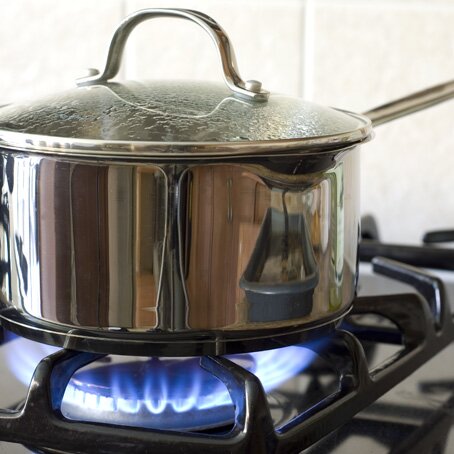Natural Gas Stoves: Everything You Need to Know

Natural gas stoves continue to be a popular choice for cooking throughout the U.S.—about 35% of homes have them, according to the U.S. Energy Information Administration. Lots of people prefer them over electric stoves because they offer greater temperature control and heat food faster. They tend to last longer than electric stoves. They’re usually gentler on cookware. And because natural gas is such an efficient fuel, gas stoves can help cut energy costs, too.
If you’re thinking about switching to a natural gas stove, we’ve put some information together in this blog that will help answer some other questions you might have.
Are natural gas stoves safe?
Yes, natural gas stoves are safe when working properly. Routine maintenance is one of the best ways to keep your gas stove running safely. You’ll want to clean your burners, grates and ignitors on a regular basis, making sure food or grease is removed. An old toothbrush and soapy water work great for this. But don’t try to clean right after cooking—your stove needs time to cool down. If you take any of the stovetop pieces apart for cleaning, be sure to place them back in the proper position.
How hot is a gas stove flame?
Natural gas flames can burn as hot as 3,560 degrees Fahrenheit. It’s important to be aware of what’s near your natural gas stove while you’re cooking. Items like plastic utensils, paper wrappings, dish rags and air-tight glass containers should be kept well away from your gas stove when it’s hot. And with such high stove temperatures, remember to keep children and pets at a safe distance.
What color should my flames be on a gas stove?
Your gas flames should be blue. If they’re yellow and orange, there could be cause for concern. Sometimes, moisture in the air can change the color of your flames. This is usually due to the use of a humidifier somewhere nearby—easily fixed by turning the humidifier off. But contaminants in your burners or improper fuel-to-air mix ratio can also change the color, which can lead to a build-up of deadly carbon monoxide gas—especially dangerous because it can’t be seen or smelled. Carbon monoxide can lead to dizziness, headaches, nausea and vomiting, so be cautious if you experience any of these symptoms while cooking. You can purchase a carbon monoxide detector for your kitchen as an extra precaution.
What if I smell natural gas?
Natural gas leaks, though rare, can be a danger as well. You’ll want to take extra care if you detect the smell of rotten eggs associated with natural gas. Turn your burners off and leave the area until the smell is gone. Malfunctioning burners and pipe connections can be potential sources of a natural gas leak. Call a professional gas technician or someone from your utility company if you suspect a gas leak or problem with your stove’s air flow.
What to consider when buying a natural gas stove.
There are many gas stove manufacturers. Your needs will determine the best model and brand for your home. Here are some factors to consider:
- Cooking efficiency: Models with higher British thermal unit (Btu) ratings usually equate to more efficient cooking. Typically, gas stove ranges vary between 5,000 and 12,500 Btu.
- Size: The average gas stove measures 30 inches wide, though there are wider and narrower options available. Be sure to choose the right size for your space. You’ll also want to consider how much you’ll be using your gas range’s oven and what you’re going to be using it for. Some come with more options to arrange oven slide racks—giving you more flexibility. Others come with a double oven that’s helpful if you do lots of baking.
- Burners: Most gas stoves have four burners, though wider ones can have more. And you’ll also want to consider the different burner output capabilities. High output burners are great for boiling water and heating food fast. Simmer burners have a lower output.
- Other features: Consider a gas range with sealed burners to keep food and other debris out. Some have self-cleaning ovens, too, which can save you time. Look for a model with easy-to-read controls, and, if you have children in your home, consider models with safety features that prevent children from getting to the cooktop and oven.
- Warranty: Read the fine print. Some manufacturers offer warranties for extended periods of time. Others will void your warranty if you move your gas range from one location to another.
How much do natural gas stoves cost?
Along with all the factors listed above, the sale price will probably be something you’ll want to weigh when choosing a natural gas range. On the smaller end (about 4.8 cubic feet), gas stoves generally vary between $400 and $600. Larger models (6 to 6.9 cubic feet) start out at about $700 and can sell for as much as $1,700.
